The global process spectroscopy industry is undergoing a transformative shift, driven by rising demand for real-time quality monitoring and regulatory compliance across manufacturing sectors. Advanced spectroscopy techniques are increasingly employed for process optimization, material identification, and environmental monitoring. In 2024, Thermo Fisher Scientific and Bruker Corporation unveiled new compact spectrometers with AI-enabled analytics, enhancing operational efficiency and precision.
The market, valued at approximately USD 20.1 billion in 2024, is projected to surpass USD 21.5 billion in 2025, advancing toward USD 45.6 billion by 2035.
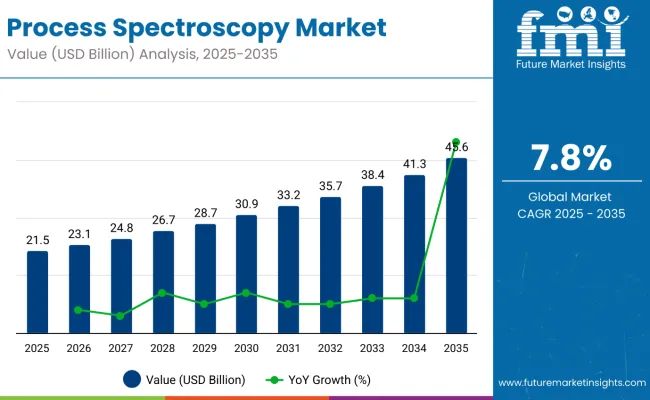
Mass spectroscopy is projected to lead in technology adoption due to its unparalleled sensitivity and specificity in chemical analysis. The pulp & paper industry is steadily integrating spectroscopy solutions to monitor raw material quality and optimize production processes amid increasing sustainability mandates.
The process spectroscopy market continues to expand rapidly, driven by rising demand for advanced analytical solutions across industries such as chemicals, pharmaceuticals, and environmental monitoring. Companies are strategically enhancing their portfolios through acquisitions and technology partnerships to stay competitive.
Reflecting this trend, Monte Hammouri, CEO of Process Insights, stated: “Tiger Optics is a great addition to the Process Insights family of businesses,” following the acquisition of Tiger Optics, a leader in cavity ring-down and laser-based spectroscopy solutions. This move underscores the growing importance of precision spectroscopy technologies in delivering real-time, high-sensitivity measurements that support process optimization, quality control, and regulatory compliance.
Key players shaping this dynamic market include Thermo Fisher Scientific, Bruker Corporation, ABB Group, Agilent Technologies, Shimadzu Corporation, Danaher Corporation, Horiba Ltd., Endress+Hauser Group, PerkinElmer Inc., and Yokogawa Electric Corporation. These companies focus on technological innovation, AI integration, and strategic partnerships with industries undergoing digital transformation.
Leading companies in the process spectroscopy market are incorporating smart technologies such as AI-driven analytics, real-time monitoring systems, automated controls, and portable instruments. These innovations support faster decision-making, higher accuracy, and increased process efficiency across industries like pharmaceuticals, chemicals, food and beverage, and environmental monitoring.
The global trade of process spectroscopy equipment is shaped by rising demand for real-time monitoring and quality control across industries such as pharmaceuticals, chemicals, food and beverage, and oil and gas. Exporting countries typically possess strong R&D capabilities, advanced manufacturing infrastructure, and global distribution networks that support the high-precision instrumentation market.
The process spectroscopy market is rapidly evolving as industries seek advanced process monitoring and quality assurance tools. Mass spectroscopy leads technology adoption for its precision, while the pulp & paper sector increasingly embraces spectroscopy to enhance efficiency and sustainability. These trends will continue to fuel market growth through 2035.
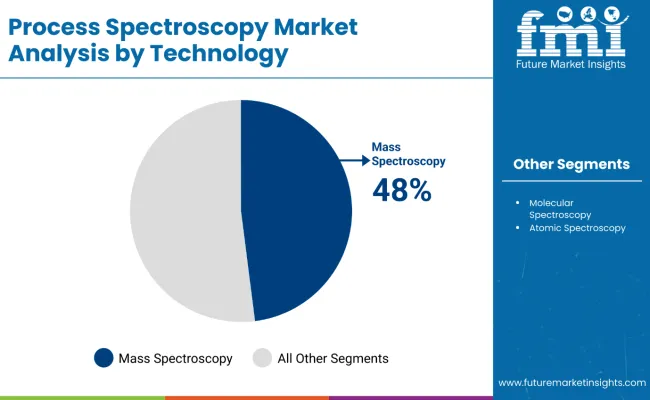
Mass spectroscopy is projected to hold a 6.3% share of the process spectroscopy market in 2025. Its ability to detect and quantify complex chemical compounds with high sensitivity makes it indispensable for industries such as pharmaceuticals, food & beverage, chemicals, and environmental monitoring.
Regulatory frameworks such as the USA FDA’s Process Analytical Technology (PAT) initiative are accelerating mass spectroscopy adoption. Pharmaceutical manufacturers, for example, deploy mass spectrometers for real-time quality control during production, reducing batch failures and ensuring regulatory compliance.
Leading companies including Thermo Fisher Scientific and Agilent Technologies have introduced advanced mass spectrometry platforms with AI-based data interpretation, enhancing usability and throughput. Additionally, miniaturization trends are enabling in-line integration of mass spectrometers within industrial production lines.
Collaborative research projects between academia and industry, particularly in Europe and North America, are driving innovations in mass spectroscopy. As industrial sectors pursue higher levels of process control and quality assurance, mass spectroscopy is expected to witness sustained growth through 2035.
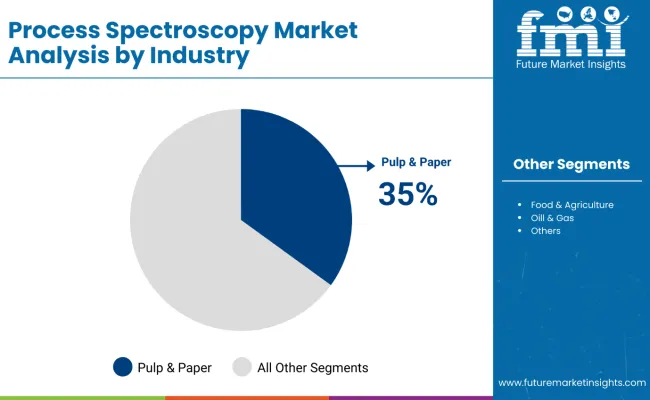
The pulp & paper industry represents 5.7% of process spectroscopy market demand in 2025, with adoption steadily rising. Growing focus on sustainability, resource efficiency, and product quality is driving the industry to adopt real-time spectroscopy solutions. Spectroscopy techniques such as NIR (near-infrared) and Raman spectroscopy are widely used to monitor pulp composition, moisture content, and chemical dosing. This enables manufacturers to optimize fiber yield, reduce energy consumption, and minimize waste.
ABB Group and Yokogawa Electric Corporation are key players supplying advanced spectroscopy systems tailored for pulp & paper processes. In 2024, ABB’s launch of a modular spectroscopy platform with seamless DCS (Distributed Control System) integration marked a significant advancement in this segment.
Moreover, the industry’s shift toward recycled fiber and alternative feedstocks requires more precise quality control, further fueling demand for spectroscopy solutions. Emerging markets in Asia-Pacific, particularly China and India, are witnessing rapid uptake as large-scale mills modernize operations. As sustainability regulations tighten and operational excellence becomes a competitive differentiator, spectroscopy adoption in pulp & paper will continue its upward trajectory through the next decade.
The global process spectroscopy industry is seen to be progressing at an unprecedented rate, which is mainly attributed to the necessity of real-time monitoring, regulatory compliance, and automation across industries. In pharmaceuticals, spectroscopy becomes the key to the precision of products and the adherence to FDA and GMP through high standards, thus guaranteeing quality control.
The food and beverage industry aims for the most economical solutions with the least error for detecting contaminants and guarantees that products are consistent. In oil & gas automation, real-time spectroscopy enables efficient fuel analysis and process optimization, subsequently minimizing time-wasting.
Chemical manufacturers employ spectroscopy while they track reactions and verify recycling materials, thus highlighting the importance of automation and the integration of AI with quality control. Environmental monitoring applications prioritize the economic aspect, the simplicity of use for measuring emissions, and the adherence to emission standard regulations.
Improvements in portable and handheld spectroscopy, AI-driven analytics, and cloud-based data integration have been made and are the key contributors to the growth, which in turn leads to the control of processes and the efficiency of operations in different industries.
| Company | Contract/Development Details |
|---|---|
| ABB Group | Secured a contract to supply process spectroscopy equipment for a major pharmaceutical company's manufacturing facilities, aiming to enhance quality control and process efficiency. |
| Bruker Corporation | Partnered with a leading petrochemical firm to provide advanced spectroscopy solutions for real-time monitoring and analysis, improving product quality and reducing operational costs. |
| Danaher Corporation | Awarded a contract to implement spectroscopy systems in multiple food processing plants, focusing on ensuring safety and compliance with industry standards. |
The industry players face numerous risks that can alter their growth trajectory. One of the foremost challenges is the high implementation and maintenance costs, which are a major concern for small and medium-sized enterprises (SMEs). Sophisticated spectrometric equipment demands high-performing and expensive hardware and software, which accompany huge expenditures on initial investments.
In addition, the intricacy of incorporating the new system into the existing industrial procedures could slow down the deployment and, as a result, increase the operational risks. Regulatory compliance is a further setback as it is extremely important in areas like pharmaceuticals, food & beverages, and chemicals that a tight quality control is observed.
The regular changes in the regulatory guidelines necessitate that the companies make continuous upgrades to their spectroscopy solutions. This not only makes the firms absorb the higher initial cost but also incurs the costs of operating the upgraded technologies.
Alongside, the integration of cloud-based spectroscopy solutions has caused concerns about data security, and the risks entailed by cyberattacks and data breaches have grown to an extent where they potentially compromise the sensitive information of the industries involved.
The economic downturn can lead to the shorter view on industrial sectors' capital expenditure, resulting in the delay of spectrometry investments. Furthermore, disruptions in the supply chain also affect the availability of key components, causing production delays and consequent price hikes. The market is extremely saturated with technological progress, which is very dynamic.
Businesses are in a relentless state of innovation or risk the threat of failure. If not handled judiciously, these threats can undermine the market's growth factor and entice the lag in various sectors. Market growth, therefore, necessitates confronting these risks through availing affordable solutions and making sure to uphold cybersecurity and compliance with regulations.
The section highlights the CAGRs of countries experiencing growth in the Process Spectroscopy market, along with the latest advancements contributing to overall market development. Based on current estimates China, India and USA are expected to see steady growth during the forecast period.
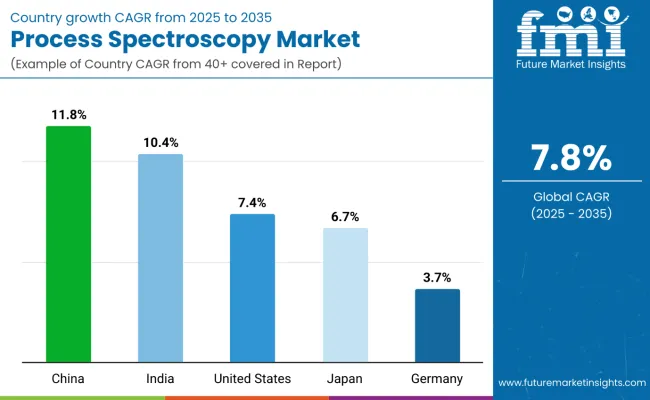
| Countries | CAGR from 2025 to 2035 |
|---|---|
| India | 10.4% |
| China | 11.8% |
| Germany | 3.7% |
| Japan | 6.7% |
| United States | 7.4% |
In the chemical industry, it helps in precise chemical composition analysis, which is vital for maintaining product standards and regulatory compliance. Also, in the metal & mining sector, it helps in the study of mineral compositions for enhancing process efficiency. The Chinese government invested in upgrading industrial technologies.
According to the Ministry of Industry and Information Technology, initiatives have been launched to promote advanced manufacturing technologies, such as the Made in China 2025 plan. In 2023, the government allocated USD 15 billion to support the adoption of high-tech analytical equipment across various industries. China is anticipated to see substantial growth at a CAGR of 11.8% from 2025 to 2035 in the process spectroscopy market.
Polymers are used in different applications, from automotive parts to medical devices. Process spectroscopy provides the tools for polymer characterization and helps ensure the performance and consistency of polymer-based products.
As the manufacturing sector holds advanced techniques, including automation and real-time monitoring, process spectroscopy becomes integral to maintaining high production standards, according to the Department of Science and Technology-funded research projects that will focus on advanced manufacturing and materials science.
The government announced a USD 10 billion investment in a national mission on advanced manufacturing to foster innovation and technology adoption in 2023. India's process spectroscopy market is growing from 1,021.4 million in 2025 to USD 2,769.1 million by 2035 at a CAGR of 10.4% during the forecast period.
Germany prioritizes environmental sustainability and efficient resource management. Process spectroscopy is an essential tool to ensure water quality and optimize treatment processes. To enable precise monitoring and ensure compliance with stringent environmental regulations, the technology allows real-time analysis of water for chemical compositions. The Federal Ministry for the Environment, Nuclear Safety, and Nature Conservation launched the Digital Water Management 2030 initiative in 2022.
The purpose of this initiative is to integrate advanced digital technologies into water management systems. This initiative allocated a budget of USD 600 million for the next five years. The will helps to enhance water quality monitoring and to improve the efficiency of wastewater treatment plants across the country. Germany is anticipated to see substantial growth in the process spectroscopy market significantly holds dominant share of 24.0% in 2025.
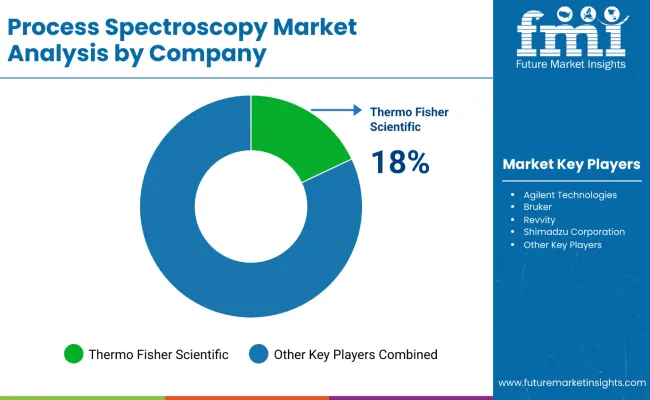
The process spectroscopy market is growing owing to various industries need sophisticated analytical, real-time monitoring, and quality control solutions. Companies compete with themselves in improving the speed, application versatility, and precision of spectroscopic technologies such as NIR, Raman, FTIR, and mass spectrometry.
The leading companies in the market with complete solutions on the spectroscopic application for pharmaceuticals, food & beverages, chemicals, and environmental monitoring are Thermo Fisher Scientific, Agilent Technologies, Bruker Corporation, Revvity, and Shimadzu Corporation. Mid-tier players Horiba, Metrohm, and ABB target specialized instruments for industry-specific applications. Newly emerging start-ups drive innovations in developing AIspectroscopy and portable devices.
The market trend is influenced by advances in automation, miniaturization, and integration with AI and IoT for real-time analytics and predictive assurance of quality. Investing in compliance-driven solutions and cloud platforms with innovative spectroscopy would give these companies an edge over competitors in times when compliance regulations are becoming more stringent. All these strategic factors encompass mergers, acquisitions, and partnerships to enhance R&D, global distribution, and technological advancements.
Increasingly, these companies will respond to market demands for precision manufacturing and sustainable practices with customizable, cost-effective, and intelligent spectroscopy solutions.
Thermo Fisher Scientific (18-22%)
The worldwide leader in spectroscopy solutions, using AI-enabled spectral analysis and automation to monitor processes better.
Agilent Technologies (14-18%)
Specializes in chemical and pharmaceutical uses, with sophisticated molecular spectroscopy and quality control solutions.
Bruker (12-16%)
A pioneer in high-resolution spectroscopy, especially in academic and industrial research applications.
Revvity (PerkinElmer) (10-14%)
Geared towards life sciences and healthcare markets, with a broad portfolio of spectroscopy and imaging technologies.
Shimadzu Corporation (8-12%)
Well-established in process control and R&D applications, with a strong presence in the pharmaceutical and chemical industries.
Other Key Players (25-35% Combined)
Recent Developments
Bruker has unveiled the BEAM, a one-point FT-NIR process spectrometer that is ideal for use in the chemical, pharmaceutical, polymer, and food industries for improving real-time process monitoring, in February 2024.
| Report Attributes | Details |
|---|---|
| Current Total Market Size (2025) | USD 21.5 billion |
| Projected Market Size (2035) | USD 45.6 billion |
| CAGR (2025 to 2035) | 7.8% |
| Base Year for Estimation | 2024 |
| Historical Period | 2020 to 2024 |
| Projections Period | 2025 to 2035 |
| Quantitative Units | USD billion for value and thousand units for volume |
| Segments Analyzed - By Component | Process spectroscopy devices, Process spectroscopy software, Services |
| Segments Analyzed - By Technology | Molecular spectroscopy, Mass spectroscopy, Atomic spectroscopy |
| Segments Analyzed - By Industry | Food & agriculture, Polymer, Pulp & paper, Chemical, Metal & mining, Water & wastewater, Pharmaceutical, Oil & gas, Others |
| Regions Covered | North America, Latin America, East Asia, South Asia & Pacific, Western Europe, Eastern Europe, Middle East & Africa (MEA), Europe |
| Countries Covered | United States, Canada, Mexico, Brazil, Argentina, Germany, France, United Kingdom, Italy, Spain, Netherlands, China, India, Japan, South Korea, ANZ (Australia & New Zealand), GCC Countries, South Africa |
| Key Players Influencing the Process Spectroscopy Market | Thermo Fisher Scientific Inc., Agilent Technologies, Inc., Bruker, Revvity (PerkinElmer Inc.), Shimadzu Corporation, Yokogawa Electric Corporation, Mettler Toledo, ABB, DH Life Sciences, LLC, HORIBA |
| Additional Attributes | Dollar sales by technology and industry, advancements in real-time process monitoring, role of spectroscopy in quality control and compliance, integration with Industry 4.0 and IoT systems, growing adoption in pharmaceuticals and food processing, regional trends in smart manufacturing applications. |
In terms of component, the segment is divided into process spectroscopy devices, process spectroscopy software and services.
In terms of technology, the industry is segregated into molecular spectroscopy, mass spectroscopy and atomic spectroscopy.
In terms of industry, the industry is segregated into food & agriculture, polymer, pulp & paper, chemical, metal & mining, water & wastewater, pharmaceutical, oil & gas and others.
A regional analysis has been carried out in key countries of North America, Latin America, East Asia, South Asia & Pacific, Western Europe, Eastern Europe and Middle East and Africa (MEA), and Europe.
The Global Process Spectroscopy industry is projected to witness CAGR of 7.8% between 2025 and 2035.
The Global Process Spectroscopy industry stood at USD 21.5 billion in 2025.
The Global Process Spectroscopy industry is anticipated to reach USD 45.6 billion by 2035 end.
South Asia & Pacific is set to record the highest CAGR of 9.2% in the assessment period.
The key players operating in the Global Process Spectroscopy Industry Thermo Fisher Scientific Inc., Agilent Technologies, Inc., Bruker, Revvity, Yokogawa Electric Corporation, Mettler Toledo and ABB.






Full Research Suite comprises of:
Market outlook & trends analysis
Interviews & case studies
Strategic recommendations
Vendor profiles & capabilities analysis
5-year forecasts
8 regions and 60+ country-level data splits
Market segment data splits
12 months of continuous data updates
DELIVERED AS:
PDF EXCEL ONLINE
Process Automation and Instrumentation Market Size and Share Forecast Outlook 2025 to 2035
Process Pipe Coating Market Size and Share Forecast Outlook 2025 to 2035
Processed Beef Market Size and Share Forecast Outlook 2025 to 2035
Processed Fruit and Vegetable Market Analysis - Size, Share, and Forecast Outlook 2025 to 2035
Process Plants Gas Turbine Market Analysis - Size, Share, and Forecast Outlook 2025 to 2035
Competitive Breakdown of Processed Beef Market Share
Market Share Insights for Processed Cashew Providers
Analysis and Growth Projections for Processed Superfruit Market
Processed Meat Market Analysis by Type, Packaging, Meat Type, and Region through 2035
Process Liquid Analyzer Market Growth - Trends & Forecast 2025 to 2035
Process Instrumentation Market Growth - Trends & Forecast 2025 to 2035
Analysis and Growth Projections for Processed Cheese Market
Evaluating Process Automation and Instrumentation Market Share & Provider Insights
Processed Cashew Market Trends – Snack Innovation & Industry Growth 2025 to 2035
Processed Meat Packaging Market Growth & Trends 2024 to 2034
Processed Eucheuma Seaweed Market
Process Analyzers Market
Reprocessed Medical Devices Market Size and Share Forecast Outlook 2025 to 2035
Coprocessor Market
Bioprocess Fermentation Monitoring Market Analysis - Size, Share, and Forecast Outlook 2025 to 2035

Thank you!
You will receive an email from our Business Development Manager. Please be sure to check your SPAM/JUNK folder too.
Chat With
MaRIA